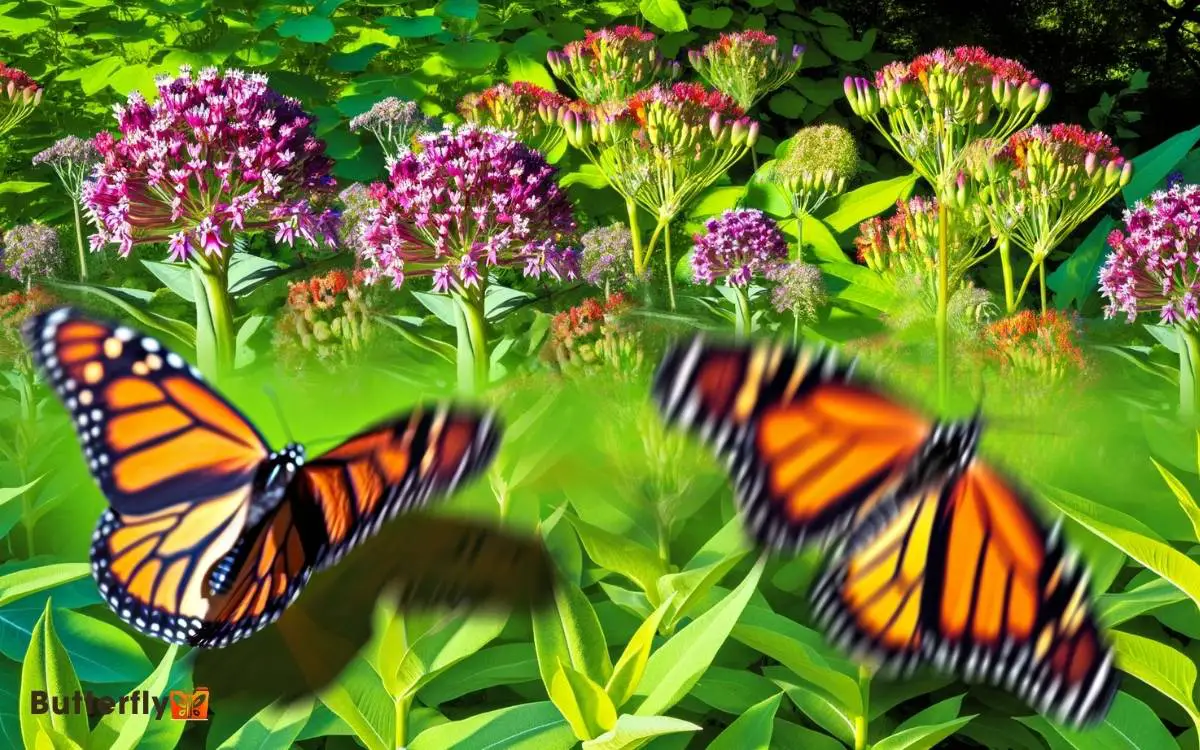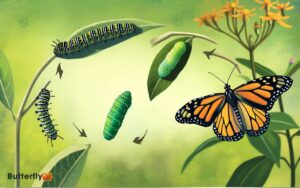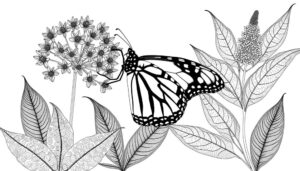Growing Milkweed for Monarch Butterflies: Step-by-Step Guide
To support monarch butterflies, grow native milkweed species like Asclepias tuberosa and Asclepias incarnata. These varieties are better adapted to local conditions and enhance larval survival rates.
Water deeply but infrequently to prevent root rot, and mulch to maintain soil moisture. Avoid pesticides and incorporate native nectar plants to attract monarchs.
Regularly monitor for pests and prune in spring for vigorous growth. Your careful preparation and maintenance will foster a thriving environment for monarch butterflies. Find detailed guidance ahead.

Key Takeaways
Choosing Milkweed Varieties
When selecting milkweed varieties, it’s important to consider the species native to your region to guarantee the best growth and support for monarch butterflies.
Native milkweed species like Asclepias tuberosa (Butterfly Weed) and Asclepias incarnata (Swamp Milkweed) are well-adapted to local soil and climate conditions, increasing their survival rates and providing ideal habitats.
Empirical data indicates that monarch larvae exhibit higher survival rates on native milkweeds. Additionally, native species are less likely to become invasive, preserving local biodiversity.
Preparing Your Garden
Begin by selecting a sunny location with well-drained soil to optimize the growth conditions for milkweed in your garden. Guarantee the site receives at least six hours of direct sunlight daily, as milkweed thrives in full sun.
Conduct a soil test to determine pH levels; milkweed prefers slightly acidic to neutral soils, with a pH range of 6.0 to 7.0.
Clear the area of weeds and debris to reduce competition for nutrients and water. Incorporate organic matter, such as compost, to enhance soil fertility and structure.
If drainage is a concern, consider creating raised beds. Mark out planting zones, ensuring sufficient spacing to accommodate mature plants, typically 18-24 inches apart.
This preparation will set the stage for successful milkweed cultivation.
Planting Milkweed Seeds
To guarantee successful germination, you should start by stratifying your milkweed seeds for at least 30 days.
Plant the seeds in well-drained soil with a pH of 6.0 to 7.0, in an area that receives full sunlight for at least six hours a day.
Aim to sow the seeds 1/4 inch deep, spacing them 18 inches apart to allow for best growth.
Seed Preparation Techniques
Properly preparing milkweed seeds for planting greatly improves germination rates and guarantees a healthy start for your monarch butterfly habitat.
Begin with stratification. Place seeds in a damp paper towel, seal them in a plastic bag, and refrigerate for 30 days. This cold treatment mimics winter conditions, enhancing germination.
Next, scarify the seeds by gently rubbing them with fine-grit sandpaper. This process breaks the seed coat, increasing water absorption.
Use sterile seed-starting mix to minimize pathogens. Sow seeds 1/4 inch deep and lightly cover with soil. Maintain consistent moisture, avoiding waterlogging.
Monitor for sprouting within 10 to 14 days. These empirical techniques will optimize your milkweed’s growth, contributing to a thriving monarch butterfly population.
Optimal Planting Conditions
After preparing your milkweed seeds, guarantee ideal planting conditions by selecting a site with full sun and well-drained soil. Aim for at least six hours of direct sunlight daily.
Soil pH should range between 6.0 and 7.0 for best growth. To enhance drainage, consider incorporating organic matter like compost into the soil.
Plant your seeds 1/4 inch deep and maintain spacing of 18-24 inches to allow sufficient room for mature plants. Water the area consistently until germination occurs, typically within 10-14 days.
Avoid overwatering, as milkweed is drought-tolerant once established. Monitoring soil moisture levels and adjusting irrigation accordingly will ensure healthy seedling development.
Caring for Seedlings
Securing the healthy growth of milkweed seedlings requires maintaining ideal soil moisture and providing sufficient light. Position your seedlings where they receive at least six hours of direct sunlight daily. Utilize a grow light if natural light is inadequate.
Monitor soil moisture closely; keep it consistently damp but not waterlogged.
Transplant seedlings once they develop two to three true leaves, making sure the roots aren’t disturbed. Space them 12-18 inches apart to allow for adequate air circulation and growth.
Protect young plants from pests by using organic deterrents or physical barriers. Regularly inspect for signs of disease or stress, such as discoloration or wilting, and act promptly to mitigate issues.
Consistent care ensures robust milkweed plants for monarch butterflies.
Watering and Soil Needs
Maintaining ideal soil conditions and a consistent watering schedule is vital for the healthy development of milkweed plants.
Milkweed thrives in well-drained soil with a pH range of 6.5 to 7.0. You should avoid waterlogged conditions, as they can lead to root rot.
Water milkweed deeply but infrequently, allowing the soil to dry between watering sessions. Empirical data suggests that a watering schedule of once per week is generally sufficient, although you may need to adjust based on local climate conditions.
Mulching around the base can help retain soil moisture and reduce evaporation. Ensure the soil is rich in organic matter to support robust growth.
Following these guidelines will promote vigorous milkweed plants, essential for monarch butterfly conservation.
Pest and Disease Management
To manage pests and diseases in your milkweed, first identify common threats like aphids and milkweed bugs. Employ organic pest control methods such as neem oil or insecticidal soap to mitigate infestations.
Additionally, follow disease prevention tips including proper spacing and adequate air circulation to reduce fungal growth.
Identifying Common Pests
Identifying common pests in your milkweed garden is crucial for effective pest and disease management, as it helps in implementing timely and appropriate interventions.
Key pests include aphids, mainly the oleander aphid (Aphis nerii), which can cause significant damage by sap-sucking, leading to weakened plants and reduced growth.
You may also encounter milkweed beetles (Tetraopes tetrophthalmus) that feed on the leaves and stems, potentially stunting growth.
Spider mites (Tetranychidae family) are another concern; they can create webbing and yellowing of leaves, indicating chlorophyll depletion.
Regular monitoring using standardized sampling methods can help you detect these pests early.
Implementing a systematic approach to pest identification will make sure your milkweed plants remain robust, supporting monarch butterfly populations effectively.
Organic Pest Control
Guarantee natural predators like ladybugs and lacewings to control aphid populations organically in your milkweed garden.
Ladybugs (Coccinellidae) consume up to 50 aphids daily, while lacewing larvae (Chrysopidae) can devour 200 aphids weekly. Introducing these beneficial insects reduces the need for chemical treatments, promoting a balanced ecosystem.
Additionally, intercropping with companion plants such as dill (Anethum graveolens) and fennel (Foeniculum vulgare) can attract these predators.
Regularly inspect milkweed leaves for aphid colonies. Employ a strong water jet to dislodge minor infestations. Neem oil, extracted from Azadirachta indica, can also serve as an effective organic deterrent.
Disease Prevention Tips
While managing pests organically is vital, preventing diseases in your milkweed garden is equally important for fostering a thriving environment for monarch butterflies.
Start by spacing your milkweed plants adequately to promote air circulation, reducing the likelihood of fungal infections. Regularly inspect leaves for signs of disease like yellowing or black spots, and promptly remove affected foliage to prevent spread.
Employ crop rotation annually to disrupt disease cycles. Utilize a 10% bleach solution to disinfect tools between uses, minimizing pathogen transmission.
In cases of severe infestation, consider introducing beneficial microorganisms like Bacillus subtilis, which competes with harmful pathogens.
Encouraging Monarch Visits
To attract monarch butterflies, make sure your garden has ample milkweed plants, as they’re the primary food source for monarch caterpillars. Position milkweed in sunny areas since monarchs prefer open, sunlit spaces.
Empirical studies suggest planting multiple milkweed species, such as Asclepias incarnata and Asclepias tuberosa, to cater to different monarch populations. Additionally, avoid using pesticides, which can harm both caterpillars and adult butterflies.
Provide water sources like shallow dishes with pebbles to aid hydration. Incorporate native nectar plants such as Lantana and Echinacea to sustain adult monarchs.
Monitoring your garden for egg-laying activity can validate your efforts. By following these guidelines, you’ll create an ideal habitat that encourages frequent monarch visits.
Harvesting Seeds
Harvesting milkweed seeds requires careful timing to guarantee the pods are mature but not yet open. Check the pods daily as they begin to yellow or brown, indicating maturity.
Gently squeeze the pods; if they feel firm, they’re ready for collection. Using sterilized scissors, cut the pods from the plant.
Place them in a breathable container, like a paper bag, to dry. After drying for one to two weeks, manually split the pods to extract the seeds.
Separate the seeds from the silky floss using a fine mesh sieve. Store the seeds in a cool, dry place inside a sealed container.
Properly harvested and stored, milkweed seeds maintain viability for several years, ensuring future planting success.
Seasonal Maintenance
Regular seasonal maintenance guarantees healthy growth and ideal conditions for milkweed plants supporting monarch butterflies.
In early spring, prune dead stems to stimulate new growth. Apply a balanced fertilizer; data shows this enhances foliar development.
As summer progresses, monitor for aphids and use insecticidal soap if infestations occur—research indicates this minimizes harm to beneficial insects. Watering should be consistent but avoid waterlogging; milkweed prefers well-drained soil.
In late fall, cut back stems to reduce overwintering pests. Mulching with organic materials helps insulate roots during colder months. Regularly check for diseases like leaf spot; remove affected leaves promptly.
These practices, grounded in empirical evidence, safeguard your milkweed remains a robust habitat for monarch butterflies.
Conclusion
Coincidentally, as you nurture your milkweed, you’ll witness an uptick in monarch butterfly visits an empirical confirmation of your effort.
The precise balance of watering, soil maintenance, and pest control fosters a thriving habitat. By diligently choosing varieties and caring for seedlings, you’re aiding monarch conservation.
Remarkably, your garden becomes a critical waypoint in their migratory journey. Harvesting seeds guarantees this cycle continues, contributing to the survival of these crucial pollinators.






